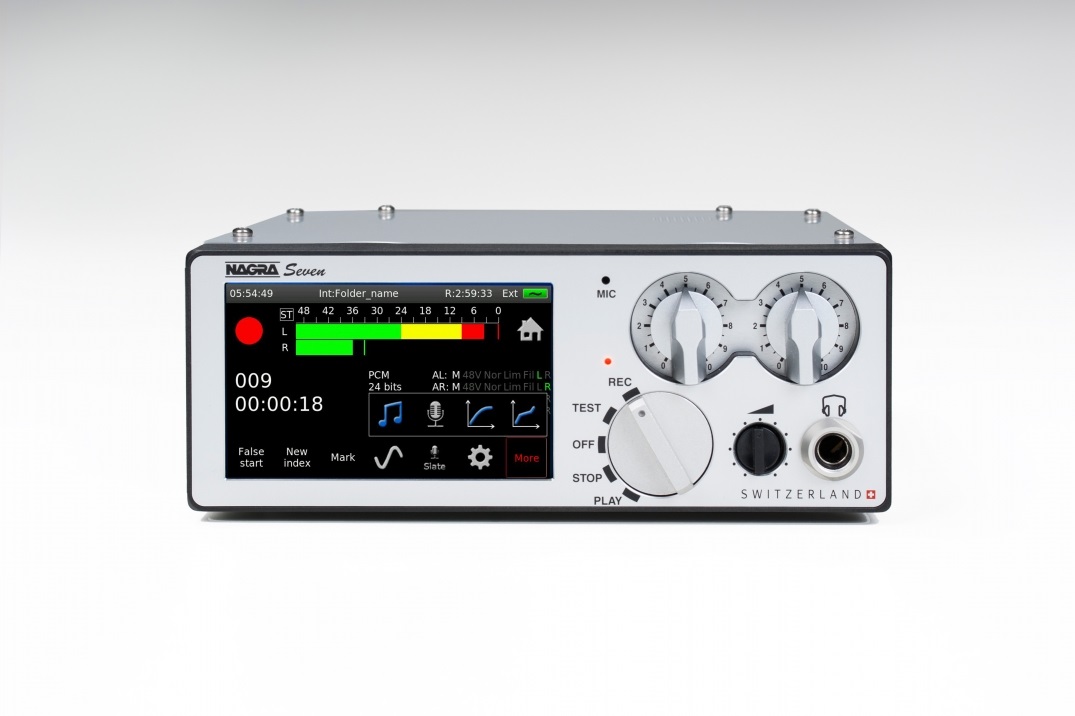The Nagra Seven has been designed as the successor to the Nagra LB, ARES-C, ARES-BB+ and Nagra V recorders. It is a flexible device and can be adapted to a multitude of specific applications depending on the internal options installed. Based on an extremely high performance, simple to operate platform the addition internal I.S.D.N. or SMPTE/EBU time code boards adapt it to either the broadcast or film / TV markets. Optional WiFi/3G, WiFi/4G, internal editor and audio compressions are also available, to further dedicate the device for particular applications.
The Seven offers two analogue audio inputs and a single stereo digital input. It will record in PCM linear audio at sampling frequencies up to 192 kHz or in MPEG-1 layer II compressed audio formats if the compression option is installed. The inputs are equipped with traditional Nagra microphone preamplifiers for dynamic and phantom +48V microphones and offer a range of switchable sensitivities to accommodate all common microphones. AES-42 microphones can also be used as the recorder can supply the necessary 10V dc supply voltage on the AES input. The analogue LINE input will accept up to +24dB allowing it to be connected to a standard audio mixer in the field.
The Nagra Seven has a state-of-the-art color touchscreen allowing greater flexibility in the display modes and screens, but also eliminating all switches which are the weakest link in modern electronics. The audio levels, current operating mode and status of the recorder are shown on the touchscreen display mounted on the front of the unit. The screen is sunlight readable, and gives access to the entire menu structure of the recorder. Various programmable “short cuts” are available giving many personalization possibilities.
The Nagra Seven is fitted with an internal 16GB micro SD flash memory, that can be increased by the user if desired. The main extractable media is an SD memory card which inserts into the slot on the left side of the recorder (see picture above).
A micro-AB USB port allows the unit to be connected to a computer for file transfer. With an interface adapter, the same port can also be used to connect an external device such as a USB memory stick or computer keyboard for data entry.
If the optional editing option is installed, then graphic editing of the audio files is possible on the main display. Once the editing of the audio material is complete, files can be transmitted to the studio either over IP (through the ethernet connection using the File Transfer Protocol “FTP” connection) or via a GSM phone using 3G/4G or by Wifi (if the option is installed).
The Nagra Seven has an optional internal time code board that works with all currently accepted frame rates including those for HD TV. It will handle both drop and non-drop frame rates, and will allow pull-up/down too.
A 3.5mm miniature Jack socket is fitted for remote fader start/stop commands. This will allow the unit to be remotely controlled by a simple switch closure.
The Nagra Seven is supplied with a detachable battery box, into which 8 rechargeable “AA” cells can be installed. An optional lithium-polymer rechargeable battery pack, that will power the unit for about 8 hours is available. If phantom powering or transmission options such as WiFi or 3G/4G are used the battery life will be reduced.

